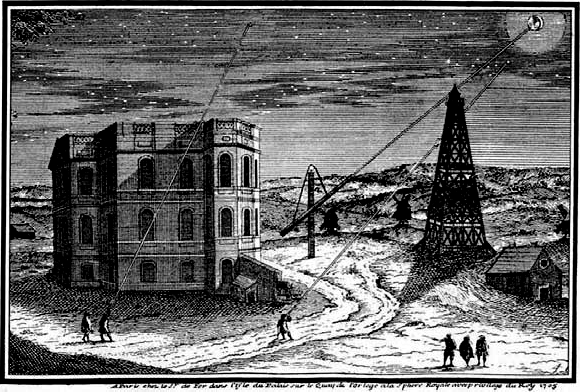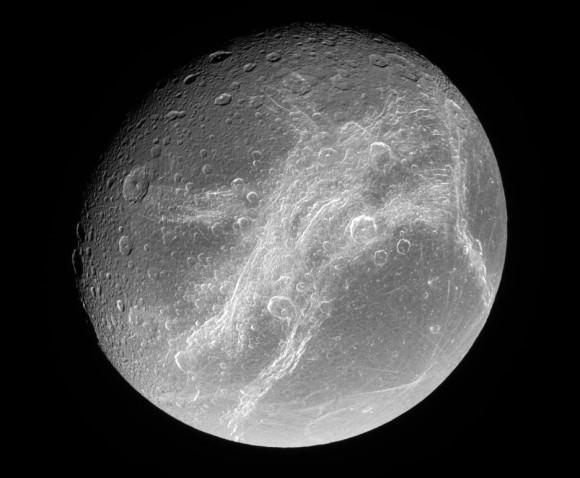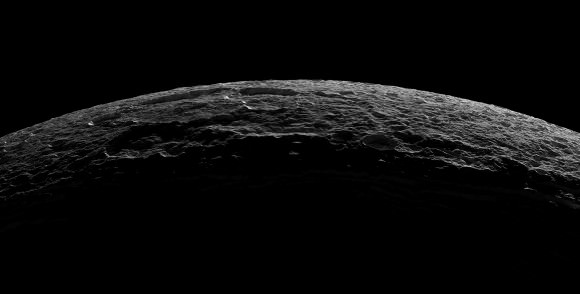Thanks to the Cassini mission, a great deal has been learned about Saturn’s system of moons (aka. the Cronian system) in the past decade. Thanks to the presence of an orbiter in the system, astronomers and space exploration enthusiasts have been treated to a seemingly endless stream of images and data, which in turn has enabled us to learn many interesting things about these moons’ appearances, surface features, composition, and history of formation.
This is certainly true of Saturn’s bright moon of Dione. In addition to being the 15th largest moon in the Solar System, and more massive than all known moons smaller than itself combined, it has much in common with other Cronian satellites – like Tethys, Iapetus and Rhea. This includes being mainly composed of ice, having a synchronous rotation with Saturn, and an unusual coloration between its leading and trailing hemispheres.
Discovery and Naming:
Dione was first observed by Italian astronomer Giovanni Domenico Cassini on in 1684 using a large aerial telescope he set up on the grounds of the Paris Observatory. Along with the moons of Iapetus, Rhea and Tethys – which he had discovered in 1671, 1672 and 1684, respectively – he named these moons Sidera Lodoicea (“Stars of Louis”, after his patron, King Louis XIV of France).
These names, however, did not catch on outside of France. By the end of the 17th century, astronomers instead fell into the habit of naming Saturn’s then-known moons as Titan and Saturn I through V, in order of their observed distance from the planet. Being the second most-distant (behind Tethys) Dione came to be known as Saturn II for over a century.

The modern names were suggested in 1847 by John Herschel (the son of famed astronomer William Herschel), who suggested all the moons of Saturn be named after Titans – the sons and daughters of Cronos in the Greek mythology (the equivalent of the Roman Saturn).
In his 1847 publication, Results of Astronomical Observations made at the Cape of Good Hope, he suggested the name Dione, an ancient oracular Titaness who was the wife of Zeus and the mother of Aphrodite. Dione is featured in Homer’s The Iliad, and geological features – such as craters and cliffs – take their names from people and places in Virgil’s Aeneid.
Size, Mass and Orbit:
With a mean radius of 561.4 ± 0.4 km and a mass of about 1.0954 × 1021 kg, Dione is equivalent in size to 0.088 Earths and 0.000328 times as massive. It orbits Saturn at an average distance (semi-major axis) of 377,396 km, with a minor eccentricity of 0.0022 – ranging from 376,566 km at periapsis and 378,226 km at apoapsis.
Dione’s semi-major axis is about 2% less than that of the Moon. However, reflecting Saturn’s greater mass, Dione’s orbital period is one tenth that of the Moon (2.736915 days compared to 28). Dione is currently in a 1:2 mean-motion orbital resonance with Saturn’s moon Enceladus, completing one orbit of Saturn for every two orbits completed by Enceladus.

This resonance maintains Enceladus’s orbital eccentricity (0.0047) and provides tidal flexing that powers Enceladus’ extensive geological activity (which in turn powers its cryovolcanic jets). Dione has two co-orbital (aka. trojan) moons: Helene and Polydeuces. They are located within Dione’s Lagrangian points, 60 degrees ahead of and behind it, respectively.
Composition and Surface Features:
With a mean density of 1.478 ± 0.003 g/cm³, Dione is composed mainly of water, with a small remainder likely consisting of a silicate rock core. Though somewhat smaller and denser than Rhea, Dione is otherwise very similar in terms of its varied terrain, albedo features, and the different between its leading and trailing hemisphere.
Overall, scientists recognize five classes of geological features on Dione – Chasmata (chasms), dorsa (ridges), fossae (long, narrow depressions), craters, and catenae (crater chains). Craters are the most common feature, as with many Cronian moons, and can be distinguished in terms of heavily cratered terrain, moderately cratered plains, and lightly cratered plains.
The heavily cratered terrain has numerous craters greater than 100 km (62 mi) in diameter, whereas the plains areas tend to have craters less than 30 km (19 mi) in diameter (with some areas being more heavily cratered than others).

Much of the heavily cratered terrain is located on the trailing hemisphere, with the less cratered plains areas present on the leading hemisphere. This is the opposite of what many scientists expected, and suggests that during the period of Heavy Bombardment, Dione was tidally locked to Saturn in the opposite orientation.
Because Dione is relatively small, it is theorized that an impact large enough to cause a 35 km crater would have been sufficient to spin the satellite in the opposite direction. Because there are many craters larger than 35 km (22 mi), Dione could have been repeatedly spun during its early history. The pattern of cratering since then and the leading hemisphere’s bright albedo suggests that Dione has remained in its current orientation for several billion years.
Dione is also known for its differently colored leading and trailing hemispheres, which are similar to Tethys and Rhea. Whereas its leading hemisphere is bright, its trailing hemisphere is darker and redder in appearance. This is due to the leading hemisphere picking up material from Saturn’s E-Ring, which is fed by Enceladus’ cryovolcanic emissions.
Meanwhile, the trailing hemisphere interacts with radiation from Saturn’s magnetosphere, which causes organic elements contained within its surface ice to become dark and redder in appearance.

Another prominent feature is Dione’s “wispy terrain“, which covers its trailing hemisphere and is composed entirely of high albedo material that is also thin enough as to not obscure the surface features beneath. The origin of these features are unknown, but an earlier hypothesis suggested that that Dione was geologically active shortly after its formation, a process which has since ceased.
During this time of geological activity, endogenic resurfacing could have pushed material from the interior to the surface, with streaks forming from eruptions along cracks that fell back to the surface as snow or ash. Later, after the internal activity and resurfacing ceased, cratering continued primarily on the leading hemisphere and wiped out the streak patterns there.
This hypothesis was proven wrong by the Cassini probe flyby of December 13th, 2004, which produced close-up images. These revealed that the ‘wisps’ were, in fact, not ice deposits at all, but rather bright ice cliffs created by tectonic fractures (chasmata). During this flyby, Cassini also captured oblique images of the cliffs which showed that some of them are several hundred meters high.
Atmosphere:
Dione also has a very thin atmosphere of oxygen ions (O+²), which was first detected by the Cassini space probe in 2010. This atmosphere is so thin that scientists prefer to call it an exosphere rather than a tenuous atmosphere. The density of molecular oxygen ions determined from the Cassini plasma spectrometer data ranges from 0.01 to 0.09 per cm3 .

Unfortunately, the prevalence of water molecules in the background (from Saturn’s E-Ring) obscured detection of water ice on the surface, so the source of oxygen remains unknown. However, photolysis is a possible cause (similar to what happens on Europa), where charged particles from Saturn’s radiation belt interact with water ice on the surface to create hydrogen and oxygen, the hydrogen being lost to space and the oxygen retained.
Exploration:
Dione was first imaged by the Voyager 1 and 2 space probes as they passed by Saturn on their way to the Outer Solar System in 1980 and 1981, respectively. Since that time, the only probe to conduct a flyby or close-up imaging of Dione has been the Cassini orbiter, which conducted five flybys of the moon between 2005 and 2015.
The first close flyby took place on October 11th, 2005, at a distance of 500 km (310 mi), followed by another on April 7th, 2010, (again at a distance of 500 km). A third flyby was performed on December 12th, 2011, and was the closest, at an distance of 99 km (62 mi). The fourth and fifth flybys took place on June 16th and August 17th, 2015, at a distance of 516 km (321 mi) and 474 km (295 mi), respectively.
In addition to obtaining images of Cassini’s cratered and differently-colored surface, the Cassini mission was also responsible for detecting the moon’s tenuous atmosphere (exosphere). Beyond that, Cassini also provided scientists with new evidence that Dione could be more geologically active than previously predicted.
Based on models constructed by NASA scientists, it is now believed that Dione’s core experiences tidal heating, which increases the closer it gets to Saturn. Because of this, scientists also believe that Dione may also have a liquid water ocean at its core-mantle boundary, thus joining moons like Enceladus, Europa and others in being potential environments where extra-terrestrial life could exist.
This, as well as Dione’s geological history and the nature of its surface (which could be what gives rise to its atmosphere) make Dione a suitable target for future research. Though no missions to study the moon are currently being planned, any mission to the Saturn system in the coming years would likely include a flyby or two!
We have many great articles on Dione and Saturn’s moons here at Universe Today. Here is one about Cassini’s first flyby, its closest flyby, it’s possible geological activity, its canyons, and its wispy terrain.
Universe Today also has an interview with Dr. Kevin Grazier, a member of the Cassini-Huygens mission.

